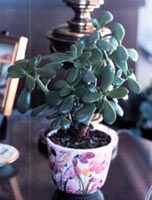Resource Library
Plant of the Week: Jade Plant
The University of Arkansas System Division of Agriculture does not promote, support or recommend plants featured in "Plant of the Week." Please consult your local Extension office for plants suitable for your region.
Plant of the Week
Jade Plant
Latin: Crassula argentea

We humans are a sentimental lot and often form emotional attachments with our plants.
Sometimes these attachments are the result of a milestone event -- a birth or passing
of a loved one -- or maybe a keepsake from a close friend. But, for these attachments
to really get strong, the plant in question has to have sticking power. It must be
a plant that just won’t die. The jade plant - even though it is just a lowly houseplant
-- is such a plant.
Our jade plant is from my father-in-law’s funeral and is a mere sapling at 10 years
of age. Frequently, you hear stories of jade plants 100 or more years old. The jade
plant is a member of the Crassulaceae family and related to sedums and many kinds
of succulent plants. It is originally from the Capetown region of South Africa and
was one of the early plants -- along with geraniums -- introduced to Europe by Dutch
settlers.
In its native habitat the jade plant will grow to 10 feet tall with leg-like branches
and a torso size trunk. Its succulent jade-green leaves are oval and as thick as a
quarter of an inch.
The jade plant does flower in Southern California where it is sometimes used as a
hedge, but seldom do blooms show themselves when grown as a houseplant. The blooms
are white, star-shaped affairs which grow to a half inch across and are borne in dense
clusters at the top of the plant.
Jade plants are desert plants and have evolved several strategies to tolerate extended
droughts. Their very succulence is the main means of combating drought, but they also
have other tricks up their sleeve. Jade plant -- and as later learned -- many other
kinds of plants adapted to drought conditions have adapted a unique way of photosynthesis
that helps conserve water. This is called CAM photosynthesis.
CAM, an abbreviation for crassulacean acid metabolism, permits the jade plant to
open its stomata (small pores on the leaves through which gas exchange occurs) at
night and absorb the carbon dioxide it needs for growth during the dark hours. The
carbon dioxide is temporarily stored as malic acid in the succulent leaves. When the
sun arrives in the morning, the stomata close to prevent water loss and the plant
then converts the stored carbon dioxide into sugar using the energy of the sun.
Though not completely indestructible, it is hard to kill a jade plant. They are slow
growing and can readily be dwarfed by keeping them in small pots. But if you want
it to grow, it responds well to regular watering and fertilization during the summer
months. A good strategy for maintaining the plant is to move it outside in the summer
to the patio where it will tolerate either full sun or full shade. In the home in
the winter it should be watered less often and receive fertilizer only if in a bright
location. It will tolerate poor light conditions during the winter without flinching.
The most common problem of jade plant is mealybugs -- a white mass of cottony froth
that attaches itself at the juncture of the leaf and stem. An easy way to control
an outbreak is by using cotton swabs and rubbing alcohol and going after the pests
one at a time.
Another ailment, though certainly less common, is sudden limb breakage. In this unusual
malady a major limb falls from the plant without warning. Several stem rotting diseases
can cause the problem and is usually a sign of overwatering.
By: Gerald Klingaman, retired
Extension Horticulturist - Ornamentals
Extension News - July 23, 1999
The University of Arkansas System Division of Agriculture does not maintain lists of retail outlets where these plants can be purchased. Please check your local nursery or other retail outlets to ask about the availability of these plants for your growing area.